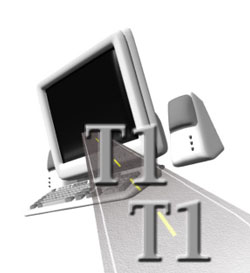When the Internet was just beginning to take off and business was starting to migrate to the Web, the connectivity of choice was the T1 line. T1 is no longer king, as business cable broadband and fiber have eclipsed it with much higher bandwidth capability and much lower prices per Mbps. Even so, there are places and applications where T1 is exactly the right fit. The only question is: “Can you still find a T1 line?”.
 Why Would You Want To?
Why Would You Want To?T1 is a technical standard introduced by the Bell system in 1962. That’s right, the telephone company. This gives you a hint for where T1 is well entrenched. It is phone systems for small and medium sized businesses. The original implementation of T1 phone lines replaced 24 twisted pair copper analog phone lines with two pair running a digital protocol. A later scheme called ISDN PRI uses the same T1 line to carry 23 phone line conversations plus switching data and caller ID.
When the long distance carriers went to T1 and its higher bandwidth T3 cousin to replace the old analog carrier systems, one thing you immediately noticed was the disappearance of noise and crosstalk. In addition to using fewer circuits, digital technology gave us higher quality conversations.
Where do you find T1 lines for phones? Any business with multiple outside lines is a candidate. The more lines, the easier it is to justify the cost of a T1 or ISDN digital line. Typically six to twelve lines make more sense on digital than analog connections. Many key telephone and PBX (Private Branch Exchange) in-house phone systems support T1 directly or can easily be interfaced.
Rock Solid Performance and Reliability
T1 lines are dedicated point to point connections. It’s a pair of wires or a couple pair that go from your location to a telco equipment office. You may get your service directly from the incumbent local telephone company or from a competitive provider that leases the lines and terminal equipment from the telco.
T1 and ISDN PRI divide the line bandwidth into channels. That’s 24 channels for T1 and 23 for ISDN. The leftover bandwidth is used by ISDN for switching, ringing and Caller ID. Whatever channels are not in use at the moment simply idle and wait to carry a phone call. Unlike typical broadband services, there is no sharing of T1 bandwidth with other businesses or consumers. The bandwidth is dedicated to your usage. It’s also symmetrical by nature. In other words the bandwidth is the same in both directions.
Another important characteristic of T1 lines is that they are synchronized at both ends using PCM or pulse code modulation to convert between analog and digital. This compares with packets used in IP networks, which do not have the timing synchronization as they do not use channels. Why does this matter? T1 lines have minimal latency. It’s just the delay through the equipment and the distance between locations. You don’t get the variable latency of Internet routing or jumbled up packets that cause dropouts and distortion in VoIP calls. This clarity and reliability of performance makes for clean reliable phone calls and also makes T1 lines great for credit card verification.
T1 Broadband…It’s a Thing
The idea of a 1.5 Mbps line called broadband is pretty much laughable these days… unless you can’t get even that. That’s right. Rural broadband is the vast wasteland of our time. There are so many locations in the boonies that get nothing. No cell phone service and certainly no cable or fiber. What they can get is T1 lines. Why? Because they are already wired for Plain Old Telephone Service (POTS). T1 was designed to run on ordinary phone cables with regeneration equipment every mile so so.
So, if you have a rural business, you can probably hook up with a T1 line or two. Have one for your phones. Another as a “last mile” connection to the Internet. You won’t be downloading 4K movies in any reasonable amount of time, but you probably aren’t doing that anyway. T1 can support your inventory management and other business software. If you need more bandwidth you can bond another T1 for 3 Mbps and more to get up to 10 or 12 Mbps. That much bandwidth won’t come cheap and isn’t available everywhere, but… if you gotta have it.
A Faster Alternative
Technology advancements have resulted in newer protocols than the sixty-something year old T1 standard. One called Ethernet over Copper uses the same multiple twisted pair cable as T1 but runs much faster. The tradeoff is distance from the equipment office. If you are within a mile or two, you may get 10 or 20 Mbps. Way out yonder, EoC probably won’t work, but T1 will. Ethernet over Copper is worth look at if you are just outside the city limits but not served by fiber or cable. Pricing is pretty attractive and you might get all the bandwidth you need.
Are other connections too unstable for your phone system or are you having trouble getting any connectivity? There are numerous carriers still supporting T1 and related technologies. Get a quote on a venerable T1 line and see if it meets your needs.

